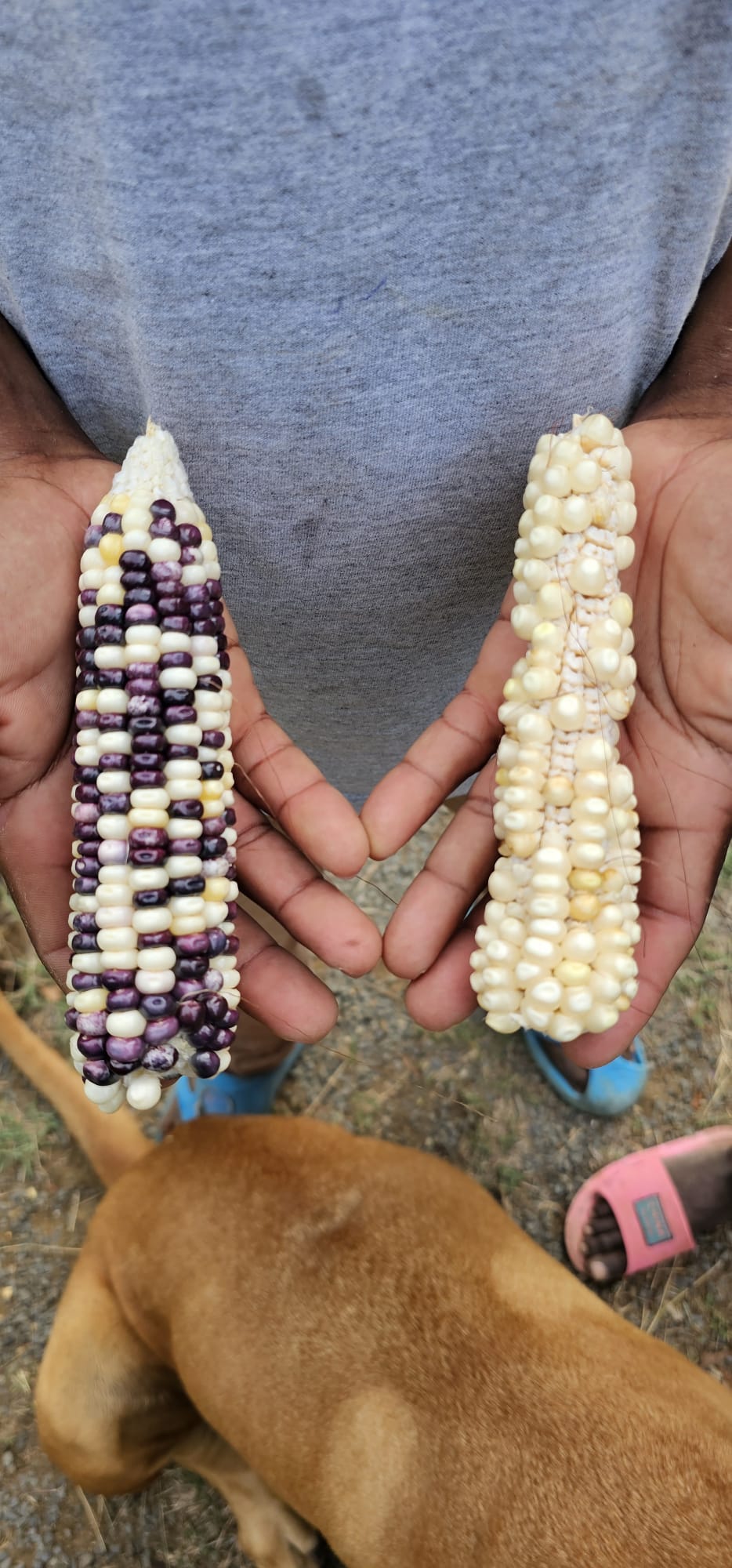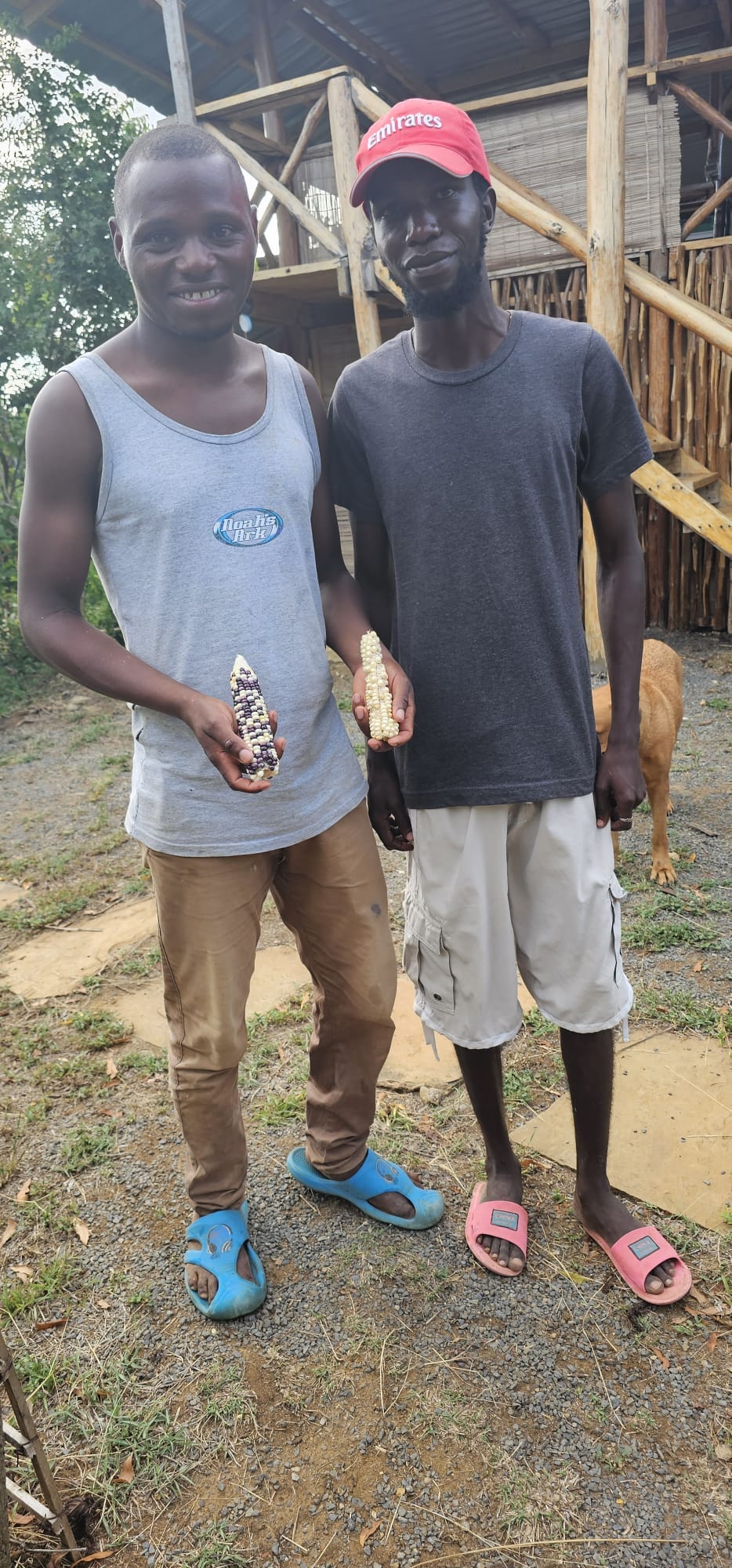Today, I stood in our garden and kept staring at two rows of corn (aka maize). We’ve grown heirloom maize (left) next to the common white maize (seen above on the right)—one carefully selected and saved by our ancestors, the other bred for industrial efficiency. The drought has been unforgiving, and the difference between these two types of maize couldn’t be clearer. The white maize, despite all its advantages in industrial farming, has struggled—its cob full of holes, its stalks less vibrant. In contrast, the heirloom maize is resilient, standing proud and healthy in the face of the same harsh conditions.
This small, side-by-side demonstration in our garden is a powerful metaphor for the choices we make, not just in what we grow but in how we live, what we value, and what we pass on. Heirloom maize, just like healthy human cultures and diverse communities, is becoming rare—an endangered species of its own. And with its fading presence, we’re losing more than a crop; we’re losing the very resilience that could sustain us through the most challenging times ahead. It’s time to bring heirloom maize back. And in doing so, perhaps we bring something of ourselves back as well.
Why We Default to White Maize
It’s easy to see why so many farmers and families have defaulted to white maize. It’s everywhere, bred to grow fast, with uniform results, yielding plenty. White maize is the product of an industrial system that values efficiency and profit over nutrition and resilience. It grows well in depleted soils with minimal input, yet each harvest offers less in nutrients than the heirloom varieties once prized by our ancestors.
And yet, by choosing what’s readily available and convenient, we’ve come to accept less for ourselves, for our communities, and for the land. We’ve allowed the richness of our agricultural legacy to be reduced to a single, over-in-bread weakened crop. We see the same pattern across many parts of life, where short-term gains and easy choices take precedence over what’s truly nourishing and resilient. It’s as if we’ve forgotten that we have other options, ones rooted in our heritage and adapted over generations to weather the storms of life.
The Cost of Choosing Convenience Over Resilience
There’s a hidden cost to planting only white maize and, metaphorically, to choosing what’s simple and quickly profitable over what’s rich and enduring. Just as the white maize in our garden shows weakness under drought, our own lives and communities can lose strength and diversity when we continually favor what’s convenient over what’s truly healthy and resilient.
Heirloom maize reminds us that monoculture—whether in our fields, our diets, or our social systems—is fragile. It’s a choice that seems efficient but is, in fact, vulnerable. When we rely too heavily on any one thing—one crop, one idea, one way of living—we risk collapse. Our gut flora, like the biodiversity in a field, thrives on variety, and dynamic equilibrium. Our communities, too, are strongest when composed of diverse and united people, skills, and ideas.
A Call to Rediscover Our Heritage
Planting heirloom maize is an act of reclaiming what’s been forgotten. It’s a way to reach back to a time when our ancestors curated crops and cultures not for fast returns but for resilience and sustenance. Each kernel of heirloom maize holds a story of survival, of adaptation, of wisdom passed down through the ages. By choosing it, we’re choosing to reweave ourselves into that heritage, to reawaken a wealth that industrial agriculture and monoculture have tried to erase.
When we look at the rows in our garden, we see more than just plants. We see a legacy of resource and commitment pooling, of shared knowledge and resources passed from hand to hand, generation to generation. Heirloom maize thrives because it has been loved and tended by countless hands, chosen not for short term profit but for the richness it brings to the soil, to the community, and to the soul.
Bringing Heirloom Maize—and Ourselves—Back
We have an opportunity to make a shift. We can bring back the heirloom maize, and with it, a culture of resilience, diversity, and health. We can choose not just what’s profitable or convenient but what enriches us—body, mind, and spirit.
Let’s make a commitment to nurture and share the heirlooms in our lives, to build a culture of resilience and mutual support. Let’s bring back the vibrant colors, the rich flavors, the strength that comes from diversity. Heirloom maize, like our own healthy communities, has become endangered, but together, we can restore it. By choosing the heirloom path, we’re choosing to bring ourselves back to a place of deeper connection, sustainability, and care.
Developing commitment pools to support fair access and economic resilience around seed banks—like those championed by Vandana Shiva—is essential for preserving biodiversity and ensuring communities have control over their food sources
Are we choosing the white maize because it’s easy?
Or are we choosing something that feeds and sustains us in a richer way?
Let’s reclaim the wealth of our heritage, for ourselves and for the future.
Let’s plant seeds of resilience, strength, and diversity—let’s bring ourselves back.
Our neighbors and friends George Shungu and Emanuel Kahindi have been watching and tasting the experiment.






🔥 Please sign and share this petition - Small things can have large impacts 🌽 https://www.change.org/maize-emoji